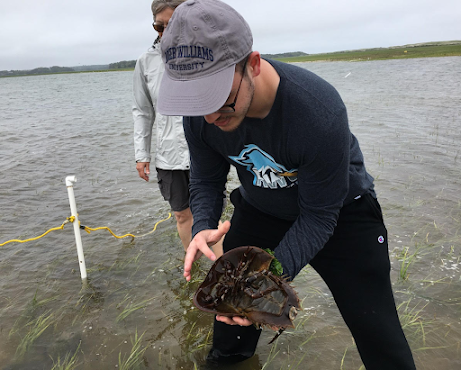Dwindling Horseshoe Crab Populations Need More Attention
by Ben Waltz, 2022 NECWA Intern
In the early parts of the Summer, when horseshoe crabs are most abundant, volunteers perform surveys to better understand how the horseshoe crab population is faring. New England Coastal Wildlife Alliance (NECWA) is one of the organizations that volunteers to take part in these surveys, organized by Mass Audubon. The data from these surveys is sent to the Massachusetts Division of Marine Fisheries (DMF) who then use this information to make decisions about the best conservation practices for horseshoe crabs.
One of the perks of these surveys is that you get to be at the beach, enjoy the nice weather, and learn. When I took part in a survey, I got to see what goes on behind the scenes. One thing I learned quickly was that female horseshoe crabs tend to be much larger than males. Size alone isn’t enough to tell them apart which is why we need to flip them over and check their pincers. Male’s pedipalps have an appearance that looks like a boxing glove while female horseshoe crab pincers all look similar. This is helpful because surveyors need to be exact when counting the number of males and females at the surveying site.
After we finished the survey we walked back, soaking wet, to our car and changed out of our cold, damp clothes as soon as we could. This might sound like a bad thing to some people but for anyone who doesn’t mind getting down and dirty it’s a great experience that I highly recommend.
What’s the Point of these Surveys?
The number of horseshoe crabs have been on a sharp decline since 1990 for a variety of reasons. One thing that sets them apart is limulus amebocyte lysate (LAL). This is a chemical that’s only found in the blood of horseshoe crabs and is widely used to test for the presence of endotoxins in the medical field.
The number of horseshoe crabs have been on a sharp decline since 1990 for a variety of reasons. One thing that sets them apart is limulus amebocyte lysate (LAL). This is a chemical that’s only found in the blood of horseshoe crabs and is widely used to test for the presence of endotoxins in the medical field.
Due to their unique blood, hundreds of thousands of horseshoe crabs are taken to laboratories each year where they’re bled and then released back into the ocean. However, up to 30% of the horseshoe crabs that are bled end up dying and others are misplaced into different locations than the ones they were taken from. To re-stabilize horseshoe crab populations, organizations such as the Atlantic States Marine Fisheries Commission (ASMFC) prohibit harvesting horseshoe crab females who have been targeted in the past due to their larger size. In order to stop the declining population of horseshoe crabs, the surveys conducted by NECWA, and other organizations are necessary so that the ASMFC, DMF, and other related companies can prevent overharvesting.
For more information about LAL and why horseshoe crabs are considered a near threatened species follow these links:
- The Atlantic: The Blood Harvest
- American Oceans: Are Horseshoe Crabs Endangered?
To learn more about what you can do to help check out these resources:
- Horseshoe Crab Recovery Coalition: The History
- Mass Audubon: Horseshoe Crab Monitoring
- NECWA: Volunteer Information






Comments
Post a Comment